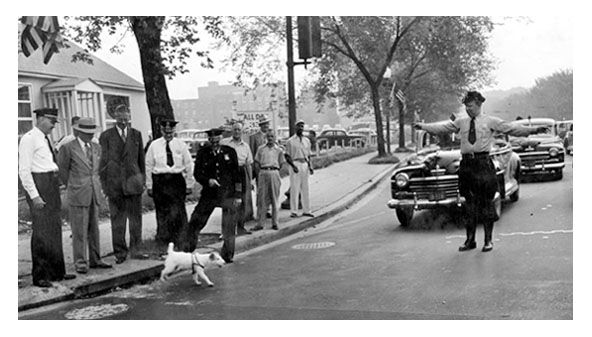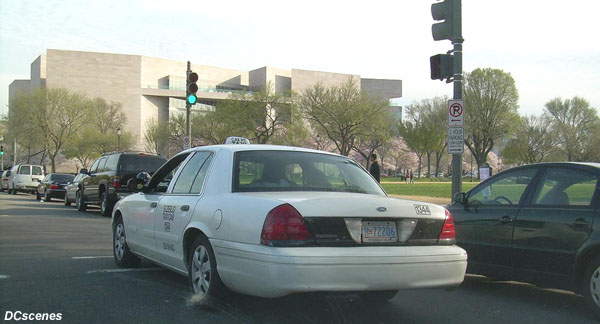Washington, D.C. Hire (Taxi) License Plates
Distinctive license plates, usually beginning with an H, have been issued for use on taxis since at least as early as 1920, the year of the earliest known example. The type was likely introduced for that year or 1919. Although this has always been the most plentiful of D.C. non-passenger types, few pre-1940 plates are held by collectors today. "Hire" is the term usually associated with plates of this type, but in DMV correspondence of the 1950s and 1960s the type is labeled "Hackers" (as shown here). Information about numbering of taxi plates appears below the photos.
 |
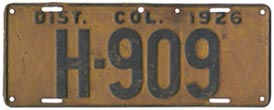 |
1922 |
1926 |
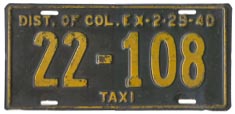 |
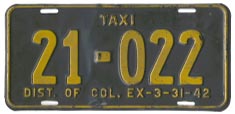 |
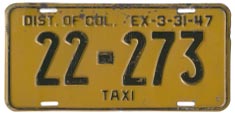 |
1939 |
1941 |
1946 |
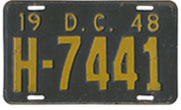 |
 |
 |
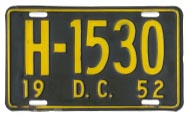 |
1948 |
1949 |
1951 |
1952 |
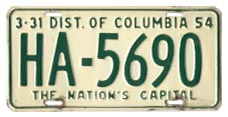 |
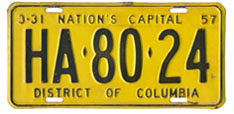 |
1953 |
1956 |
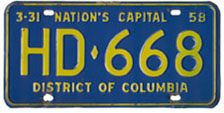 |
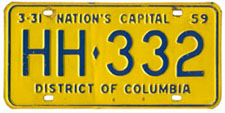 |
1957 |
1958 |
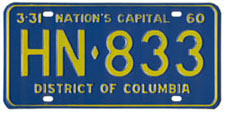 |
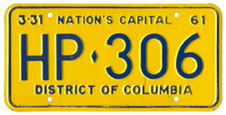 |
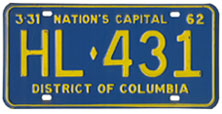 |
1959 |
1960 |
1961 |
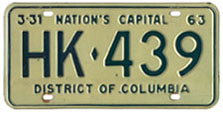 |
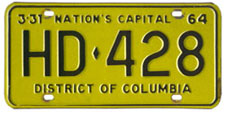 |
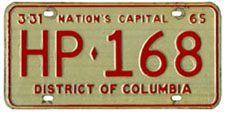 |
1962 |
1963 |
1964 |
After 17 years (1948-1964) of issuing new plates annually, in early 1965 the D.C. DMV introduced a four-year baseplate for use on taxis. These black-on-white plates were revalidated for the 1966, '67, and '68 registration years with a sticker bearing the expiration year (i.e. "67," "68," and "69"). However, new transactions processed during the 1968 registration year were evidenced by a set of HT-series plates with no sticker. This issuance pattern is a duplicate of that used for truck plates, which is further explained here.
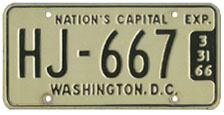 |
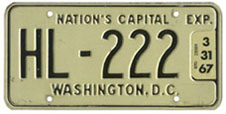 |
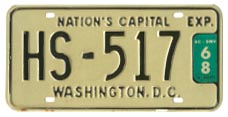 |
1965 |
1966 |
1967 |
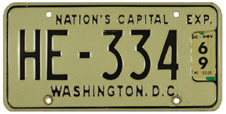 |
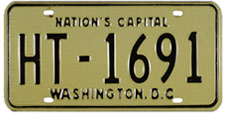 |
1968 renewal registration |
1968 new registration |
From 1969 (exp. 3-31-70) through 1973 (exp. 3-31-74) new dated plates were issued annually. Numbers were assigned sequentially from a common starting point, presumably H-101, for the first four years of this era. For 1973 the sequence picked up near where plates of 1972 had ended, which explains the unusually high numbers on 1973 plates of this and certain other types. More information about taxi plate numbering is provided below.
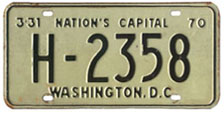 |
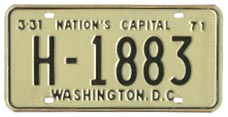 |
1969 |
1970 |
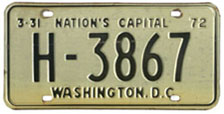 |
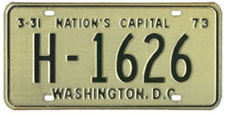 |
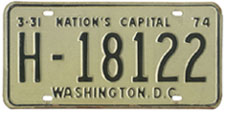 |
1971 |
1972 |
1973 |
 |
1974 Baseplate It is assumed that this baseplate was issued for taxis during the same period that it was issued for private passenger vehicles, that being April 1974 through March 1978. We also assume that H-101 was the first number issued because 101 is the known starting point for other types on this base. The highest number observed is B-13076. |
|
1974/1978 baseplate cutoff point documentation gap: H-13077 to H-17770 (4,694 numbers) |
||
 |
1978 Baseplate This base was probably issued only for new registrations from April 1978 through Sept. 1984, as was the case with auto plates of the same design. Hire plates issued during the 1980 registration year have a green back, as do auto plates issued at the same time. The lowest and highest numbers observed on this base are H-17771 and H-23238. | |
1978/1984 baseplate cutoff point documentation gap: H-23239 to H-35077 (11,809 numbers) |
||
 |
1984 Baseplate This base was likely introduced in Oct. 1984, when the design was introduced for passenger car plates, or possibly shortly thereafter. All 1974 and 1978 baseplates then in use were likely replaced by plates of this design. The lowest and highest numbers observed on the 1984 base are H-35078 and H-60508. |
|
1984/1993 baseplate cutoff point documentation gap: H-60509 to H-63808 (3,300 numbers) |
||
 |
1993 Baseplate Although the Celebrate and Discover slogan was introduced for auto plates in mid-1991, it was probably a few more years before all 1984 baseplates could be issued, at which time the change would have been reflected on taxi plates. The lowest and highest numbers observed on plates with the slogan at the top are H-63809 and H-76457. |
|
1993/1997 baseplate cutoff point documentation gap: H-76458 to H-76518 (61 numbers) |
||
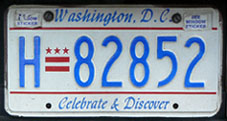 |
1997 Baseplate When the general-issue passenger registration number format was changed to AB-1234 in April 1997, the position of the city name and slogan were reversed. This change is thought to have been reflected in taxi plates during 1997 or 1998. The lowest and highest observed numbers of this base are H-76519 and H-83999. | |
1997/2001 baseplate cutoff point documentation gap: H-84000 to H-84007 (8 numbers) |
||
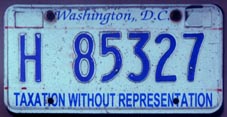 |
2001 Baseplate The first taxi plates with the TAXATION legend have an embossed number so we assume they were issued during 2001, shortly after the passenger version of this base was introduced in Nov. 2000. The lowest and highest observed numbers in this relatively small batch of plates are H-84008 and H-85421. (Red graphic elements of no. H-85327 have faded after years of use.) | |
2001/2002 baseplate cutoff point documentation gap: H-85422 to H-85512 (91 numbers) |
||
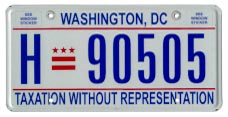 |
2002 Baseplate We believe that flat taxi plates began to be issued in early 2002. It is almost certain that there are two variants. Because plate stickers were still being used when this base style was introduced, they presumably do not have SEE WINDOW STICKER printed in the upper corners. The lowest observed flat style taxi plate is H-85513. Additional notes about recent taxi plates are provided below. | |
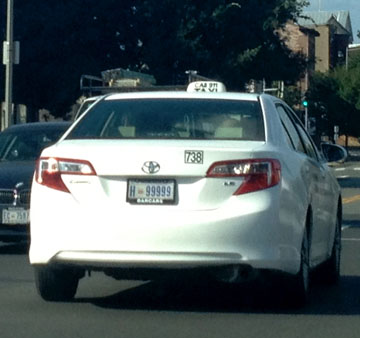 |
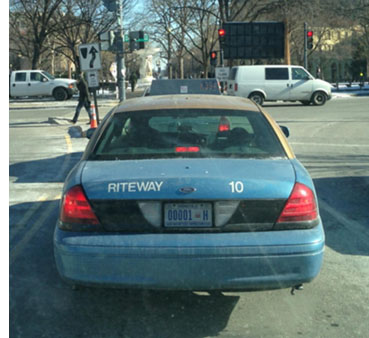 |
Out With The Old, In With The New In early 2011 the sequence of H-prefix hire registration numbers that began in 1974 at H-101 came to an end at H-99999. Whether the next series began at 00000-H or 00001-H is unknown but if the plates on these cabs were not issued consecutively there is only a single number that separates them. Close-up images of H-suffix plates appear below. |
Taxi Plate Numbering
This is as good a page as any upon which to devote a little space to the subject of non-passenger plate numbering in general and the numbering of one type in particular because more taxi registrations have always been issued annually than any other type. In general terms, this discussion applies to plates of several types, especially the few most closely associated (in appearance and numbering) with Hire: Bus, Sightseeing Bus (the later version), and Livery. It's easiest to study Hire, however, because there is more extant evidence. For example, during the eight-year period of 1957 (3-31-58) through 1964 (3-31-65), when each plate was used for a one-year period and numbered with a single serial letter and numbers 100 through 999 following the type designation letter, Hire plates are known to have been issued as high as the HP series whereas the highest-numbered Bus and Livery plates begin with BD and LA, respectively.
Before 1948. The earliest taxi plates begin with a letter H. Presumably, this designation was used through 1934, after which type designation prefix letters were replaced by all-number registrations and the type name embossed above or below the number. This format was used until the expiration of the 1946 (dated 3-31-47) base, which was revalidated for the 1947 registration year with a tab marked "48." During this period, based upon known examples it appears that taxi plates were numbered in the 20-000 and 30-000 series.
1948-1952. During this five-year period, D.C. plates were marked with the year of issue, not the expiration date, as was done before and after (i.e. for the 1947-48 and 1953-54 registration years). DMV documentation clearly indicates that for 1948 and 1949, Hire plates were numbered H-1 through H-9999. We have not seen the equivalent documentation for 1950.
For 1951 and 1952, the wording is changed slightly from 1948 and 1949 to suggest that perhaps number H-1 through H-999 were no longer issued, and that taxi plate numbering thus began at H-1000, but we believe it to be unlikely that this change was actually made. Judging by the existence of used 1949 plate number H-9229, close to (if not more than) 10,000 taxi plates were required annually, and undoubtedly most (if not all) individuals to whom the lowest numbers were assigned in 1948 and 1949 coveted them, so it doesn't make sense that the 999 plates with the "best" numbers would be removed from circulation as the years passed and presumably more plates were required in the prosperous post-war years.
 Therefore, we assume that throughout this period numbers were assigned sequentially beginning at H-1. We have seen no 1948-51 hire plates numbered in any format other than that characterized by an H followed by up to four numbers, although we believe that if more than 9,999 plates were required in any year these "overflow series" numbers would follow the format discussed and pictured on our page about Commercial plates (except that an H would appear instead of a C, of course). To summarize, for 1948 through 1951 we believe that the type designator would appear one space to the right, which is to say that numbers would begin at 1-H1 and continue through 1-H999 (and then 2-H1 through 2-H999, etc.). For 1952, the overflow format was changed to feature a serial letter following the type designator, so numbers assigned after H-9999 would be HA-1 through HA-999, HB-1 through HB-999, etc.
Therefore, we assume that throughout this period numbers were assigned sequentially beginning at H-1. We have seen no 1948-51 hire plates numbered in any format other than that characterized by an H followed by up to four numbers, although we believe that if more than 9,999 plates were required in any year these "overflow series" numbers would follow the format discussed and pictured on our page about Commercial plates (except that an H would appear instead of a C, of course). To summarize, for 1948 through 1951 we believe that the type designator would appear one space to the right, which is to say that numbers would begin at 1-H1 and continue through 1-H999 (and then 2-H1 through 2-H999, etc.). For 1952, the overflow format was changed to feature a serial letter following the type designator, so numbers assigned after H-9999 would be HA-1 through HA-999, HB-1 through HB-999, etc.
1953 and 1954 ("3-31-54" with "55" tab). The 1953 base, the first since 1946 marked with its expiration date instead of the year of issue, mostly follows the 1948-52 numbering format. Because it was issued and used for two years, however, more registration numbers were required then in 1952. Therefore, plates numbered higher than H-9999 again were needed (as presumably they were, albeit in lesser quantities, during the previous five years). Instead of issuing numbers H-10000 and higher, which could have been accommodated on the new, larger plates, the 1952 overflow format was used, although modified such that up to four numbers appear following the type designator and serial letters. The example pictured above, number HA-5690, represents the 15,689th taxi registration issued during the two-year period (if we assume that numbers H-1 through H-9999 and HA-1 through HA-5689 were issued before it was assigned).
1955 ("3-31-56") and 1956 ("3-31-57"). DMV documentation for these years indicates that Hire plates are numbered from HA-10-00 through (theoretically) HZ-99-99. It is possible, however, that numbers did not reach HA-99-99 in either year, which is to say that there may not have been 9,000 taxis registered annually at the time. If there were, the HB series would have been used, although no HB-series plates are known. Number HA-80-24 pictured above is the 7,025th 1956 Hire plate issued.
1957 ("3-31-58") Through 1964 ("3-31-65"). This era is represented by plate numbers comprised of two letters followed by three numbers, and registration numbers with leading zeros (e.g. HA-001) were not issued. The first letter on Hire plates is always H and the second character is serial, with F, I, O, and Q not used. Numbers begin at 100 and end at 999, resulting in 900 combinations for each letter series. That F, I, O, and Q were not used on 1957 plates is unspecified in DMV documentation about plates of that year, but this distinction is made about 1958 and later plates so we have assumed that the exclusion of these letters also applies to 1957. Also, official documents in which 1963 (3-31-64) and 1964 (3-31-65) plates are described are not quite as clear as documents about 1957-62 plates, but we have assumed, because the numbering format is consistent, that everything known about 1957-62 Hire plate numbering also applies to 1963 and 1964 plates.
The highest observed Hire registration number of this era is HP-306. Information about 1957-64 Hire plate numbering is shown in this table:
Quantity of Available Numbers |
Example From |
Equivalent All-Numeric |
|||
Series |
Available Numbers |
Per Series |
Cumulative |
Plates Pictured |
Registration |
HA |
HA-100 to HA-999 |
900 |
900 |
||
HB |
HB-100 to HB-999 |
900 |
1,800 |
||
HC |
HC-100 to HC-999 |
900 |
2,700 |
||
HD |
HD-100 to HD-999 |
900 |
3,600 |
HD-428 (1963) |
3,029 |
HE |
HE-100 to HE-999 |
900 |
4,500 |
||
HG |
HG-100 to HG-999 |
900 |
5,400 |
||
HH |
HH-100 to HH-999 |
900 |
6,300 |
HH-332 (1958) |
5,633 |
HJ |
HJ-100 to HJ-999 |
900 |
7,200 |
||
HK |
HK-100 to HK-999 |
900 |
8,100 |
HK-439 (1962) |
7,540 |
HL |
HL-100 to HL-999 |
900 |
9,000 |
HL-431 (1961) |
8,432 |
HM |
HM-100 to HM-999 |
900 |
9,900 |
||
HN |
HN-100 to HN-999 |
900 |
10,800 |
HN-833 (1959) |
10,634 |
HP |
HP-100 to HP-999 |
900 |
11,700 |
HP-306 (1960) |
11,007 |
1965-1968 ("3-31-66" with "67," "68," and "69" stickers; undated for new 1968 registrations). Numbering for this four-year baseplate largely follows the 1957-64 pattern, although later hire plates of this period exhibit the effect of provisions adopted in mid-1964 that increased the number of available registration combinations, which officials recognized would be needed when multi-year baseplates were introduced. Registration number guidelines that appear in a June 1964 DMV directive clearly anticipate the issuance of multi-year baseplates, which by the mid-1960s were being issued in many of the states, including nearby populous ones (such as Pennsylvania, New Jersey and New York), those that often set registration-related trends that smaller jurisdictions dutifully followed. Curiously, however, much of the expanded population of available non-passenger numbers appears to have not been used.
The first portion of non-passenger registration numbers of types such as Bus, Hire, and Livery was unchanged for the 1965 multi-year base: plates still began with a type designation letter followed by a serial letter taken from an alphabet that did not include F, I, O, or Q. Where changes were made was to the numeric portion of the registration. Whereas previously numbers in each letter series began at 100 and ended at 999, providing 900 different numeric combinations, the population was expanded to include numbers 001 through 9999, space for the sixth character being available due to the use of new dies that are substantially narrower than those of the previous eight years. Specifically, Hire plates could be numbered from HA-001 through HA-999 as well as HA-0001 through HA-9999. When plates of each letter series numbered 001 through 099 were to have been issued (or were issued, if in fact they were) is unknown.
Even though these long-format numbers were available, however, surviving hire plates appear to indicate that they were not used until late in this four-year period. Therefore, we believe that a determination was made before the beginning of the 1965 registration year to begin by issuing plates in the traditional numbering format and range, namely HA-100 through HA-999, HB-100 through HB-999, etc., until the supply of such numbers was depleted, only then beginning with HA-0001 (or perhaps HA-1000) through HA-9999.
Whereas through the 1964 ("3-31-65") plate the highest Hire registration number observed is in the HP series, used HR-series plates on the 1965 base are known. (By the time these plates were made the debossed "3-31-66" year designation had been removed from the vertical sticker area to the right of the number.) Although the unused HS-series plate pictured above (no. HS-517) conforms to the traditional numbering format, unissued HT-series plates with numbers such as HT-013 and HT-027 are known. Whether any Hire plates with leading zeros were issued is unknown.
For 1968 existing plates were revalidated with a sticker but new registrations were evidenced with undated HT-series plates, most (or perhaps all) of which feature four numbers. The same system was used for truck plates (as discussed here), and it was apparently not deemed necessary to affix 1968 stickers (marked "69") to these plates because new passenger car plates for this year were also not dated in any manner.
1969 ("3-31-70") Through 1973 ("3-31-74"). License plates with black characters on a reflective white background were issued annually during this five-year period. We believe that for 1969 through 1972 numbering began at H-101 and progressed as high as necessary. For 1973, however, numbers began at a point close to where 1972 registrations had ended, which accounts for the unusually high numbers seen on 3-31-74 taxi plates.
Since 1974, taxi license plates have been identical in their design to private passenger car plates, and the designs have been changed simultaneously. Numbering began at H-101 in 1974 and progressed sequentially to H-99999 in early 2011, at which time the type designation letter was moved to the right of the number. The first reported observations of plates in this new format were registration number 00009-H, seen in use on February 13, 2011, and 00106-H seen two days later. As is evident in these photograph of plates 00006-H and 00201-H, these plates feature the city name printed in a condensed font that has also been observed on Trailer plates. The highest observed plate with the standard font is H-97727, and the lowest with the condensed font is H-98281.
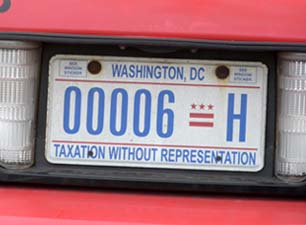
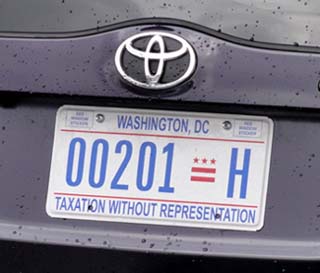
Estimate of Taxi Registration Numbers Assigned Annually Since 2005
Approximately 100,600 pairs of taxi plates were issued during the 38-year period from 1974 through 2011. If all of them were issued in conjunction with a new registration, there would have been an average of 2,647 new registrations annually during this 38-year period. However, there likely was a complete reissuance of taxi plates in the mid-1980s, as there was with passenger car plates. Based upon the relatively small quantity of data that we have about taxi plates, we believe that during the 15 most recent years of this period the number of annual new registration transactions has been closer to 1,250.
Year |
Estimate of Numbers Assigned |
Quantity of Estimated |
2005 |
H-91500 to H-92889 |
1,390 |
2006 |
H-92890 to H-94999 |
2,110 |
2007 |
H-95000 to H-96099 |
1,100 |
2008 |
H-96100 to H-97349 |
1,250 |
2009 |
H-97350 to H-98499 |
1,150 |
2010 |
H-98500 to H-99899 |
1,400 |
2011 |
H-99900 to H-99999 |
100 |
00000-H to 00849-H |
850 |
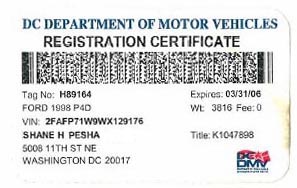 |
This current style Washington, D.C. registration certificate, for hire plate no H-89164, expired at the end of March 2006. The vehicle is a 1998 Ford four-door, probably a Crown Victoria like the one pictured above. These forms are printed on the same sheet as, and therefore simultaneously with, windshield stickers used to display the registration's validity. |
|
This page last updated on December 31, 2017 |
 |
|
copyright 2006-2018 Eastern Seaboard Press Information and images on this Web site may not be copied or reproduced in any manner without consent of the owner. For information, send an e-mail to admin@DCplates.net |















